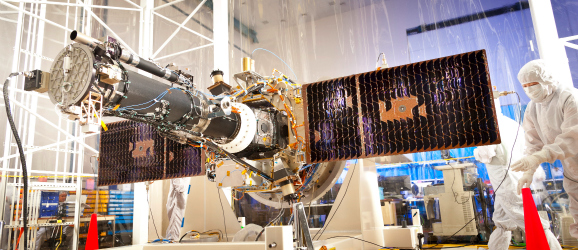NASA Sun Study Mission Launches This Month
This article is more than 2 years old
 Remember the movie Sunshine? Danny Boyle’s science fiction film followed a manned mission to the Sun, and while that’s still in the realm of science fiction, NASA scientists are planning to launch a 400-pound probe to observe the Sun. Thankfully they’ll aren’t trying to re-ignite it with a nuclear weapon.
Remember the movie Sunshine? Danny Boyle’s science fiction film followed a manned mission to the Sun, and while that’s still in the realm of science fiction, NASA scientists are planning to launch a 400-pound probe to observe the Sun. Thankfully they’ll aren’t trying to re-ignite it with a nuclear weapon.
NASA’s Interface Region Imaging Spectrograph (IRIS) is scheduled to launch on June 26, 2013 from Vandenberg Air Force Base in California. Its mission is to study the Sun’s corona, or upper layer of atmosphere, which emits temperatures of about 1 million Kelvins (about 1.8 million Fahrenheit). Surprisingly, the Sun’s corona is actually much hotter than its surface. Relative to the Sun’s overall size, the corona is about 3,000 to 6,000 miles thick. According to Joe Davila, IRIS project scientist at NASA’s Goddard Space Flight Center:
IRIS will extend our observations of the sun to a region that has historically been difficult to study. Understanding the interface region better improves our understanding of the whole corona and, in turn, how it affects the solar system.
IRIS will collect data about the Sun’s corona while taking high-resolution images of the Sun’s surface at about one percent of the Sun’s size at a time.
Lockheed Martin and the University of Oslo in Norway built IRIS with a specific ability to collect data on the velocity, temperature, and density of energy the Sun emits. IRIS is the first of its kind, and can interpret this data into specialized graphs and information at NASA’s Ames Research Center in Moffett Field, California, which will serve as IRIS’s mission control back on Earth. Bart De Pontieu, the IRIS science lead at Lockheed Martin said of the solar probe:
When you observe the interface region, there is no intuitive approach to understanding the light’s path from the sun’s surface and that’s been a major stumbling block. We’re trying to understand something that’s hidden in a fog — but now, thanks to the enormous advance of computers and sophisticated numerical models, the fog is lifting.
Once IRIS is launched at the end of June, it will join other Sun observatories orbiting the Earth, including NASA’s Solar Dynamics Observatory and the joint NASA-Japan Aerospace Exploration Agency’s Hinode. Hopefully IRIS’s mission will go smoother than that of the Icarus II.
Read more about IRIS at NASA.gov.












